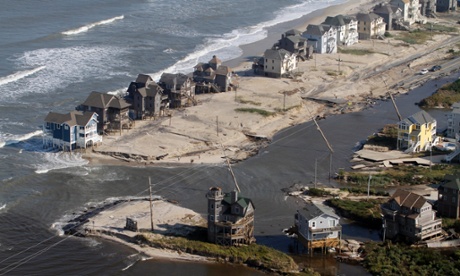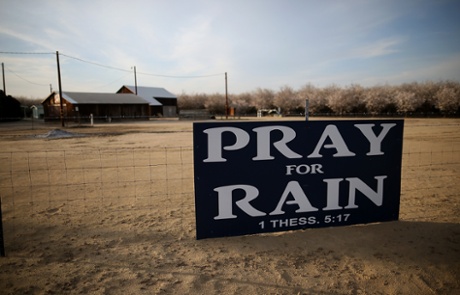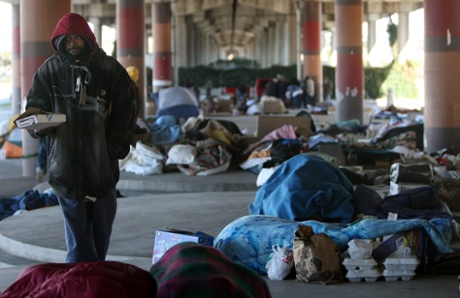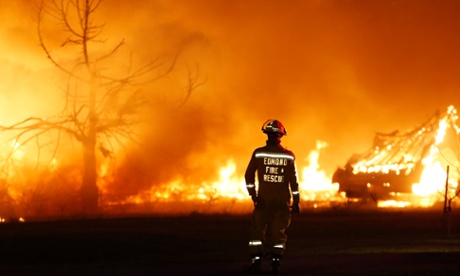
My verdict
Climate change will break hard upon the US. How hard? In what manner? And where? These are the questions this report has illuminated. But which impacts will be most disastrous is difficult to answer.
Our question may have been ill-conceived. Certainly extreme rainfall, wildfire and drought and sea level rise are among the most prevalent examples of the danger of carbon pollution. But the biggest take home message from the National Climate Assessment is not about particular threats. Rather it tells us that climate change is pervasive. In differing, incomparable ways it will affect every society, industry and region in the country. The biggest threat for Floridians might be sea level rise. In the north east, it will likely be extreme rainfall events. Whereas Californians are already experiencing a crippling drought.
Where we do find a country-wide trend is on the plight of the vulnerable. The poorest people (thus some communities of colour) will be hit hardest. Even in the self-appointed icon of modernity and civilisation, climate justice should be part of the debate. Those who have benefitted most from the emissions of industry will likely suffer the least from climate change.
Thanks for the comments, tweets and emails today!
Updated
Marshall Shepherd, 2013 president of American Meteorological Society, says there is probably not a definitive answer to the greatest threats facing the US. Rather, climate change confronts every part of the country with its own, individual problems.
But if he had to choose some major impacts, he says, he would point to the increased extremities in rainfall and drought observed already in the US and rising sea levels. The seriousness of these events has been exacerbated by demographic shifts as people leave the rural heartland in search of sun, sand and cities.
"For the first time in history we are an urbanised society. More people live in cities than in the country," he says. The increase in urbanisation has led to a rapid increase in the amount of impervious surfaces, which makes for more floods. A concurrent migration to the coast makes sea level rises more dangerous as more homes are built on areas vulnerable to storm surges.

Note: Dr Shepherd was referring to the majority of the global community living in cities for the first time. Thanks to reader Quentin Kilpatrick for picking up on this. The growth in US urban population continues to outpace other parts of the country.
@Guardian @KarlMathiesen Is the quote from @DrShepherd2013 out of context? Definitions change but US has been majority urban since 1920.
— Quentin Kilpatrick (@qkilpatrick) May 7, 2014
Updated
NGO reaction
Jamie Henn, 350.org's communications director believes the impacts of climate change are galvanising Americans to take part in civil action on climate change.
"I think the recent surge in climate activism here in the United States has been a direct result of the impacts people are seeing all around them. Hurricane Sandy especially really shocked the American public into action and supercharged the climate movement here. From the fossil fuel divestment movement, which has become the largest campus based campaign in the country, to the fight against Keystone XL, climate change is putting more Americans in the streets--and sending more to jail in acts of civil disobedience--than ever before. I think the National Climate Assessment could be another turning point. We've got the diagnosis, we know the prescription, now it's time to take action."
WWF vice president for climate change Lou Leonard said:
“This report reads like it was ripped from today’s headlines. It paints the clearest picture yet that extreme weather and climate disruption are already here and, simply put, it’s not pretty. While climate impacts are significant, the good news here is that we can avoid the dangerous future predicted this report if we start today using this information to prepare our cities for these risks and changing the way our nation uses and chooses energy."
Agriculture
The effect of climate change on US agriculture is complicated, says the report. Some crops will benefit from higher temperatures, longer growing seasons and increased CO2.
"Climate change has the potential to both positively and negatively affect the location, timing, and productivity of crop, livestock, and fishery systems at local, national, and global scales," the report said.
But disruptions to the industry have increased over the past 40 years. Farmers have so far proven equal to the task of adaptation, with US income from agriculture steadily rising.
The report concludes that the cumulative impacts of variable weather, changing conditions, weeds, diseases, pests, drought, flood and soil erosion will eventually outpace innovation and cause a drop in agricultural output.
Global warming won't be kind to agriculture in California's Central Valley: http://t.co/N31S9pymdC pic.twitter.com/xa8s4EBzSt
— brad plumer (@bradplumer) May 6, 2014
Agriculture secretary Tom Vilsack said today:
"The National Climate Assessment confirms that climate change is affecting every region of the country and critical sectors of the economy like agriculture. This assessment provides an unprecedented look at how the changing climate and extreme weather impact rural America. The Obama Administration continues to take steps to responsibly cut carbon pollution, slow the effects of climate change and support an expanded domestic energy economy. At USDA, we're working closely with our nation's farmers, ranchers and forest landowners to help them manage the negative impacts of climate change, reduce their energy costs, and grow the bioeconomy to create jobs in rural America."
It seems the message is reaching the American corn heartland with the De Moines Register warning that Iowan growers are vulnerable to extreme weather events destroying crops. Iowa is a key electoral state, meaning this narrative could be exceptionally important for the Democrats in 2016.

Updated
Impacts on the poor and people of colour
Globally, climate change has long been identified as a north-south issue. Its impacts being disproportionately loaded onto the already heaving shoulders of the world's poorest people. But this report makes it clear that in wealthy America, climate change is also an issue of poverty and race.
"Climate change will, absent other changes, amplify some of the existing health threats the nation now faces. Certain people and communities are especially vulnerable, including children, the elderly, the sick, the poor, and some communities of colour."
Hurricane Katrina is the precedent for the way in which disasters in America prey upon the vulnerable and the disenfranchised.
"Climate change will disproportionately affect low-income communities and some communities of colour, raising environmental justice concerns. Existing health disparities and other inequities, increase vulnerability. Climate change related issues that have an equity component include heat waves, air quality, and extreme weather and climate events. For example, Hurricane Katrina demonstrated how vulnerable certain groups of people were to extreme weather events, because many low-income and of-color New Orleans residents were killed, injured, or had difficulty evacuating and recovering from the storm."
There are also major impacts on indigenous peoples in America, whose lives are more intrinsically tied to the environment and therefore more sensitive.
"Climate change threatens Native Peoples’ access to traditional foods and adequate water. Alaskan Native communities are increasingly exposed to health and livelihood hazards related to rising temperatures and declining sea ice. Climate change impacts are forcing relocation of some Native communities."

Updated
Your comments
Updated
Hurricanes
One of the major debates on climate change is whether major storms are happening more often. It seems the jury is still out in the National Climate Assessment.
There is limited historical data about hurricanes, making trends difficult to find. It is clear that North Atlantic hurricanes have increased since the 1980s. There is evidence that other decades in the past 200 years have seen high levels of activity. There is also a downward trend in the North Pacific.
Hurricanes in North Atlantic will increase in frequency, intensity and duration, says NCA. pic.twitter.com/ExJ5DqPz6P
— Karl Mathiesen (@KarlMathiesen) May 6, 2014
The report says:
"The relative contributions of human and natural causes to these increases are still uncertain. Hurricane-associated storm intensity and rainfall rates are projected to increase as the climate continues to warm."
One area where models project a high level of confidence is on hurricane precipitation.
"Almost all existing studies project greater rainfall rates in hurricanes in a warmer climate, with projected increases of about 20% averaged near the centre of hurricanes," says the report.
The report is now being launched at the White House. You can watch it live here.
Twitter reaction
Extreme weather disasters fueled by climate change cost our economy more than $100 billion in 2012. #ActOnClimate pic.twitter.com/dSXq8dSAHx
— The White House (@WhiteHouse) May 6, 2014
#NCA2014 gives #ClimateDeniers no room to argue. #Climatechange is real, happening now & impacts severe http://t.co/MHaPzzFuNJ #ActOnClimate
— Rep. Henry A. Waxman (@WaxmanClimate) May 6, 2014
More communities will be vulnerable to Lyme disease, other ailments if we don't #ActOnClimate. More: http://t.co/C4jY2Qhz6M #ActOnClimate
— John Podesta (@Podesta44) May 6, 2014
#Obama continues the lies about climate change while Liberals enrich themselves & destroy American economy! #NJ #tcot http://t.co/WXZ1Huz8bW
— W Republicans (@AllRepublicans) May 6, 2014
Midwest: benefits of longer growing season already offset by "extreme events such as heat waves, droughts, & floods" http://t.co/LGdRepRr2A
— Matt Lehrich (@Lehrich44) May 6, 2014
The #NCA2014 is clear: We have to act now to reduce carbon pollution and prepare for the effects of climate change. http://t.co/wIgUMan5wT
— Barack Obama (@BarackObama) May 6, 2014
Meanwhile, the GOP are using their Twitter account to push Keystone XL.
Retweet & Sign if you support the #KeystoneXL JOBS pipeline http://t.co/fYg1ePQWei Tell #Obama: Build it now. pic.twitter.com/QtJTcRFMgN
— RNC (@GOP) May 5, 2014
Wildfire and sea level rise
Tony Janetos, an ecologist who has been an author on all three National Climate Assessments, says wildfire (such as the one now raging in Oklahoma) and sea level rise are the most damaging manifestations of climate change.
"They are immediately apparent. We have a lot of data. They serve as exemplars of the kind of event we will see more of," he says. Adding that climate change makes naturally occurring events worse. "What climate change does is it loads the dice. It starts to accentuate the extremes."
Janetos says the effects of storm surge, made worse by sea level rise has caused "damage to coastal infrastructure and property as well as damage to life and limb". Whereas wildfire is dangerous to people, threatening lives through their increasing ferocity and also causing respiratory problems by releasing particulates into the atmosphere. It also damages the environment by destroying habitat. Both have already had severe economic impacts.
He says he is "worried by effects and impacts that are larger and occurring more rapidly [than expected] and to me that's a very serious concern and we have to take these response options seriously".

The NCA reports:
"Between 1970 and 2003, warmer and drier conditions increased burned area in western U.S. mid-elevation conifer forests by 650%."
On top of the immediate damage and danger, the effect of smoke on human health can be "extremely harmful":
Wildfires, which are projected to increase in some regions due to climate change, have health impacts that can extend hundreds of miles. Forest fires in Quebec, Canada, during July 2002 resulted in up to a 30-fold increase in airborne fine particle concentrations in Baltimore, a city nearly a thousand miles downwind. These fine particles are extremely harmful to human health, affecting both indoor and outdoor air quality. An average of 6.4 million acres burned in U.S. wildfires each year between 2000 and 2010, with 9.5 million acres burned in 2006 and 9.1 million acres in 2012. Global deaths from wildfire smoke have been estimated at 260,000 to 600,000 annually.
Smoke from fires affecting Baltimore air qual 1000 miles away. #NCA pic.twitter.com/dhtv4PGeg6
— Karl Mathiesen (@KarlMathiesen) May 6, 2014
Storm surges will reach further inland as the sea level rises. This threatens power plants in California, land and homes in Louisiana and massive parts of Florida, including Miami. Across the country it will have a large and expensive effect on transport, energy and water and waste infrastructure. Eroding pipes, disrupting roads and subways and requiring increased energy consumption to defend coastlines against encroachment.
In New York State, two feet of sea level rise is estimated (absent adaptation investment) to flood or render unusable 212 miles of roads, 77 miles of rail, 3,647 acres of airport facilities, and 539 acres of runways. Port facilities, such as in Maryland (primarily Baltimore), also have flooding impact estimates: 298 acres, or 32% of the overall port facilities in the state.
In Boston... cumulative damage to buildings and building contents, as well as the associated emergency costs, could potentially be as high as $94 billion between 2000 and 2100
Updated
Multiple system failure in extreme events
The catastrophic events of Hurricane Katrina in 2005 have lead scientists to warn that major weather events caused by climate change could "exceed our capacity to respond". This is because they overwhelm every aspect of infrastructure that we rely on to keep us alive. It is this "multiple system failure" that compounds the effects of large scale events and confounds emergency response.
"Impacts are particularly severe when critical systems simultaneously fail... Infrastructure and evacuation failures and collapse of critical response services during a storm is one example of multiple system failures. Another example is a loss of electrical power during heat waves or wildfires, which can reduce food and water safety. Air conditioning has helped reduce illness and death due to extreme heat, but if power is lost, everyone is vulnerable."
The recurrence of a storm equal to or greater than Katrina is a nightmare made more likely by climate change.
This White House fact sheet details the climate trends affecting America. But which ones will be worst?
• Temperature: “U.S. average temperature has increased by 1.3°F to 1.9°F since record keeping began in 1895; most of this increase has occurred since about 1970. The most recent decade was the Nation’s warmest on record. Temperatures in the United States are expected to continue to rise. Because human-induced warming is superimposed on a naturally varying climate, the temperature rise has not been, and will not be, uniform or smooth across the country or over time.”
• Extreme Weather: “There have been changes in some types of extreme weather events over the last several decades. Heat waves have become more frequent and intense, especially in the West. Cold waves have become less frequent and intense across the Nation. There have been regional trends in floods and droughts. Droughts in the Southwest and heat waves everywhere are projected to become more intense, and cold waves less intense everywhere.”
• Hurricanes: “The intensity, frequency, and duration of North Atlantic hurricanes, as well as the frequency of the strongest (Category 4 and 5) hurricanes, have all increased since the early 1980s. The relative contributions of human and natural causes to these increases are still uncertain. Hurricane-associated storm intensity and rainfall rates are projected to increase as the climate continues to warm.”
• Severe Storms: “Winter storms have increased in frequency and intensity since the 1950s, and their tracks have shifted northward over the United States. Other trends in severe storms, including the intensity and frequency of tornadoes, hail, and damaging thunderstorm winds, are uncertain and are being studied intensively.”
• Precipitation: “Average U.S. precipitation has increased since 1900, but some areas have had increases greater than the national average, and some areas have had decreases. More winter and spring precipitation is projected for the northern United States, and less for the Southwest, over this century.”
• Heavy Downpours: “Heavy downpours are increasing nationally, especially over the last three to five decades. Largest increases are in the Midwest and Northeast. Increases in the frequency and intensity of extreme precipitation events are projected for all U.S. regions.”
• Frost-free Season: “The length of the frost-free season (and the corresponding growing season) has been increasing nationally since the 1980s, with the largest increases occurring in the western United States, affecting ecosystems and agriculture. Across the United States, the growing season is projected to continue to lengthen.”
• Ice Melt: “Rising temperatures are reducing ice volume and surface extent on land, lakes, and sea. This loss of ice is expected to continue. The Arctic Ocean is expected to become essentially ice free in summer before mid-century.”
• Sea Level: “Global sea level has risen by about 8 inches since reliable record keeping began in 1880. It is projected to rise another 1 to 4 feet by 2100.”
• Ocean Acidification: “The oceans are currently absorbing about a quarter of the carbon dioxide emitted to the atmosphere annually and are becoming more acidic as a result, leading to concerns about intensifying impacts on marine ecosystems.”
All quotes from the National Climate Assessment.
The Huffington Post's take on the "five scariest charts" in the report is worth a look. It focusses on more rain, almost ubiquitous warming, more 100F (38C) days, increasing drought and the fact that if carbon emissions continue at the current rate, things will get much, much worse.
Precipitation
The NCA singles out rainfall as a key aspect of the changing climate. The below image shows incidents of very heavy rainfall increased dramatically in the eastern states since 1958, but the change across North America will not be homogenous.
more heavy rain - especially in eastern states. #nca pic.twitter.com/2kljFYf5Cx
— Karl Mathiesen (@KarlMathiesen) May 6, 2014
In the future, "the contrast between wet and dry areas will increase both in the US and globally – in other words, the wet areas will get wetter and the dry areas will get drier." This change has already been observed.
"Average U.S. precipitation has increased since 1900, but some areas have had increases greater than the national average, and some areas have had decreases. More winter and spring precipitation is projected for the northern United States, and less for the Southwest, over this century."
Observed US Precipitation Change. 1991-2012 compared to the 1901-1960 average. pic.twitter.com/tLnfSugr2I
— Karl Mathiesen (@KarlMathiesen) May 6, 2014
This means two things: more droughts and more heavy downpours. The report warns that the impacts on human health on flooding, beyond the immediate risk of drowning, are waterborne disease outbreaks and mould infestations causing respiratory problems.
"At the opposite end of precipitation extremes, drought also poses risks to public health and safety. Drought conditions may increase the environmental exposure to a broad set of health hazards including wildfires, dust storms, extreme heat events, flash flooding, degraded water quality, and reduced water quantity."
Updated
A good wrap of reaction is available on AdaptNY's Storify.
Climate deniers should take a hard look at what #NCA2014 says about their communities. It’s time to #ActOnClimate. http://t.co/gdyw3LzqOA
— Sheldon Whitehouse (@SenWhitehouse) May 6, 2014
News wrap
The New York Times reports that "one of the report’s most dramatic findings concerned the rising frequency of torrential rains".
Time says "the south west will bake, Alaska will melt, coastlines will be in danger and agriculture will be resilient… at first".
Marshall Shepherd, 2013 president of American Meteorological Society says in the Washington Post that "this report, for Americans, is a bit closer to home and should generate a buzz. But, will it?"
The Daily Mail says "the number and strength of extreme weather events have increased over the past 50 years".
Updated
Welcome to the eco audit
Climate change is already causing devastation and disruption across the US, says the most comprehensive scientific paper on climate change the country has ever published.
The National Climate Assessment (NCA) has told of a litany of devastating events and subtle creeping degradation that are the result of warming accelerated by industrial pollution.
The Guardian's Suzanne Goldenberg reports that 300 researchers found "climate change has moved from the corners of the earth into the American backyard".
“I think maybe this report will be the turning point when people finally realise that this is about them,” Susan Hassol, the chief science writer on the report, told the Guardian. “It's about them and their lives … Earlier, they had seen it as a distant threat – distant in time, distance in space, this is about poles, this is about island nations. They haven't seen it as a threat in their own backyard.”
The language of the report was deliberately straightforward. “Climate change, once considered an issue for a distant future, has moved into the present,” the report begins. “Americans are noticing changes all around them. Summers are longer and hotter … winters are generally shorter and warmer. Rain comes in heavier downpours.”
Today I will be going through the report and listening to the reaction to discover which effects of climate change will be the most disruptive to life in America.
Join in today’s discussion by contributing in the comments below, tweet me or email me. If you are quoting figures or studies, please provide a link to the original source. Follow me on @karlmathiesen for updates throughout the day and later I will return with my own verdict.
Updated











The growing season in places like Canada will be much longer, which may compensated for the increase in extreme weather.